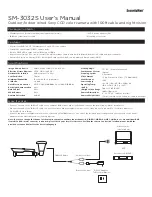
SELP1650 (E 3.5-5.6/PZ 16-50 OSS) (E PZ 16-50mm F3.5-5.6 OSS)
4-9
4-3-2. Projective Resolving Power Check
Reference value
Focal length f
(mm)
Projection
distance (m)
Number of the smallest pitched (lines/mm)
Center (y’ = 0)
Peripheral (y' = 10)
Peripheral (y' = 12)
S
M
S
M
16
0.64
More than 80
lines
More than 32
lines
More than 32
lines
More than 20
lines
More than 20
lines
24
0.96
35
1.4
50
2.0
Checking Procedure
1. Set the projection distance of the Lens Test Projector (F). (Refer to “Reference value”)
2. Set the focus.
3. Bring the projector into focus so that fine lines of the center projected image (y’= 0) on the screen can be clearly seen as much as possible by
operating the program screen.
Sagittal (S)
Meridional (M)
The number of projective
resolving power lines
Use the small projected image.
(for High frequency)
4. Read the value of the number of projective resolving power lines (maximum resolving power) of the center projected image (y’ = 0).
5. Read the value (the number of projective resolving power lines) of the thinnest line (resolution limit) that allows recognition of contrast of the
sagittal (S) image and meridional (M) image (three lines) of the peripheral projected image (y’ = 10, 12).
Note:
Be careful of spurious resolution when checking the resolution limit.
Spurious resolution is a phenomenon where fine lines beyond resolving power are visible as black and white stripes as if resolution is made.
In this case, black and white of three stripes are reversed and seen as if they are two or four lines in some cases. Be careful not to confuse this phenomenon
with the resolution limit.
Correct resolution
Spurious resolution
6. Change the focal length and projection distance of the checking lens, and confirm that the number of projective resolving power lines of the S
image and M image meets the reference value at each focus and projection distance using the same procedure.
7. If the reference value is not satisfied, perform the “4-4. RESOLVING POWER ADJUSTMENT”.
















































